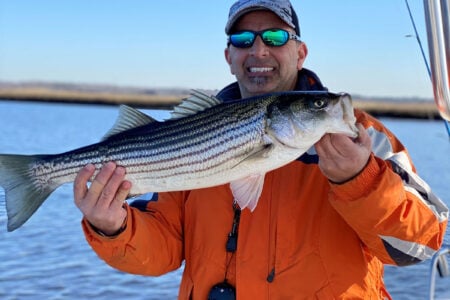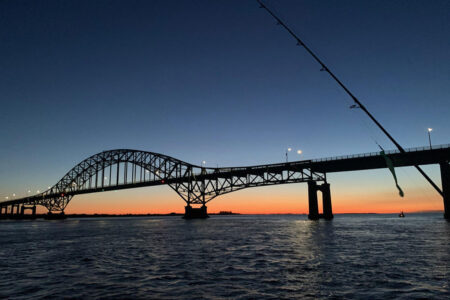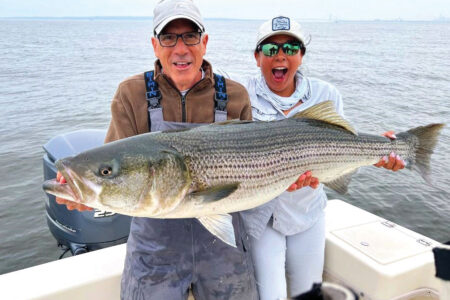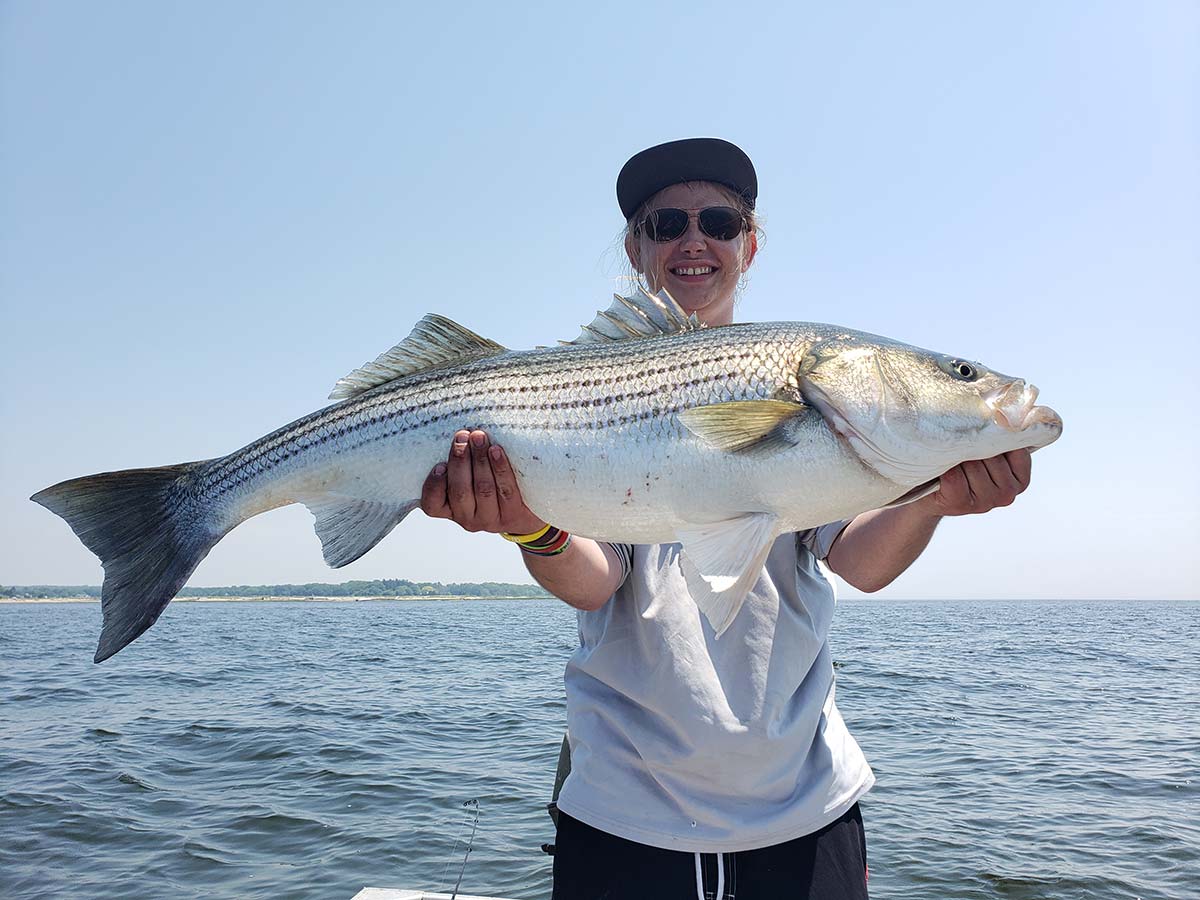
Timing the spring striper run on the Connecticut River.
Every year around the end of May, migratory striped bass make their way back down from the warming waters of the upper Connecticut River, toward the cooler saltwater closer to Long Island Sound. Along this route, these large bass often encounter a strong push of bunker, or “menhaden”, and with this abundance of baitfish, it’s not uncommon to find stripers helping themselves to the all-you-can-eat buffet!
This bite can last anywhere from a couple weeks, to well into the summer, depending on a few factors, with water temp and the presence of baitfish topping the list. Generally speaking, the longer the adult bunker stick around, the longer the bass do, with the peak of the bite typically occurring in early to mid-June and tapering off when the water temperature reaches 80 degrees.
At The Start
Early on in the run, some of the best fishing can be done with a simple fishfinder rig, paired with sea worms fished on the bottom. A fishfinder rig consists of a circle hook tied onto on a leader, preferably fluorocarbon, attached to the main line with a barrel swivel. On the main line is a sliding rig with a large snap attached, this is where you will attach your sinker. The sliding rig ensures that when a fish takes the bait, it does not feel any resistance from the sinker. The angler will be watching his rod tip, looking for signs of a bite and, when he sees the rod tip bounce, he’ll grab the rod, reel down to the fish and gently lift the rod, setting the circle hook.
The bass tend to be more lethargic in early May thanks to the cooler water temps and anglers find that they are not as eager to chase down artificial lures. Many people think this worm fishery will only produce schoolies, but fish of all sizes will eat a big, juicy worm and fish over 40 inchers are landed every spring using this method. It’s just a matter of using the right method for the time of year.
If fishing bait on the bottom is just not your cup of tea, don’t worry, these fish will still choke down artificials, but early in the run, when the water is still very cold, the slower and steadier the retrieve, the better! An early season artificial that has been crushing stripers over the past few years, has been the pearl white Albie Snax, from Fish Snax Lures, paired with a 3/4-ounce jighead. Oftentimes anglers will snip off the first 1/4- to 1/2-inch of the front of the plastic so it matches up seamlessly to the jighead. Adding a drop of Gorilla Super Glue to fix the plastic to the jighead also helps tremendously to save your plastics. This combination seems to be most effective when fished like a bucktail jig, feathering the bottom. The key to this method is to swim your Snax just above the bottom and keep it moving very slowly, only touching the bottom now and then.
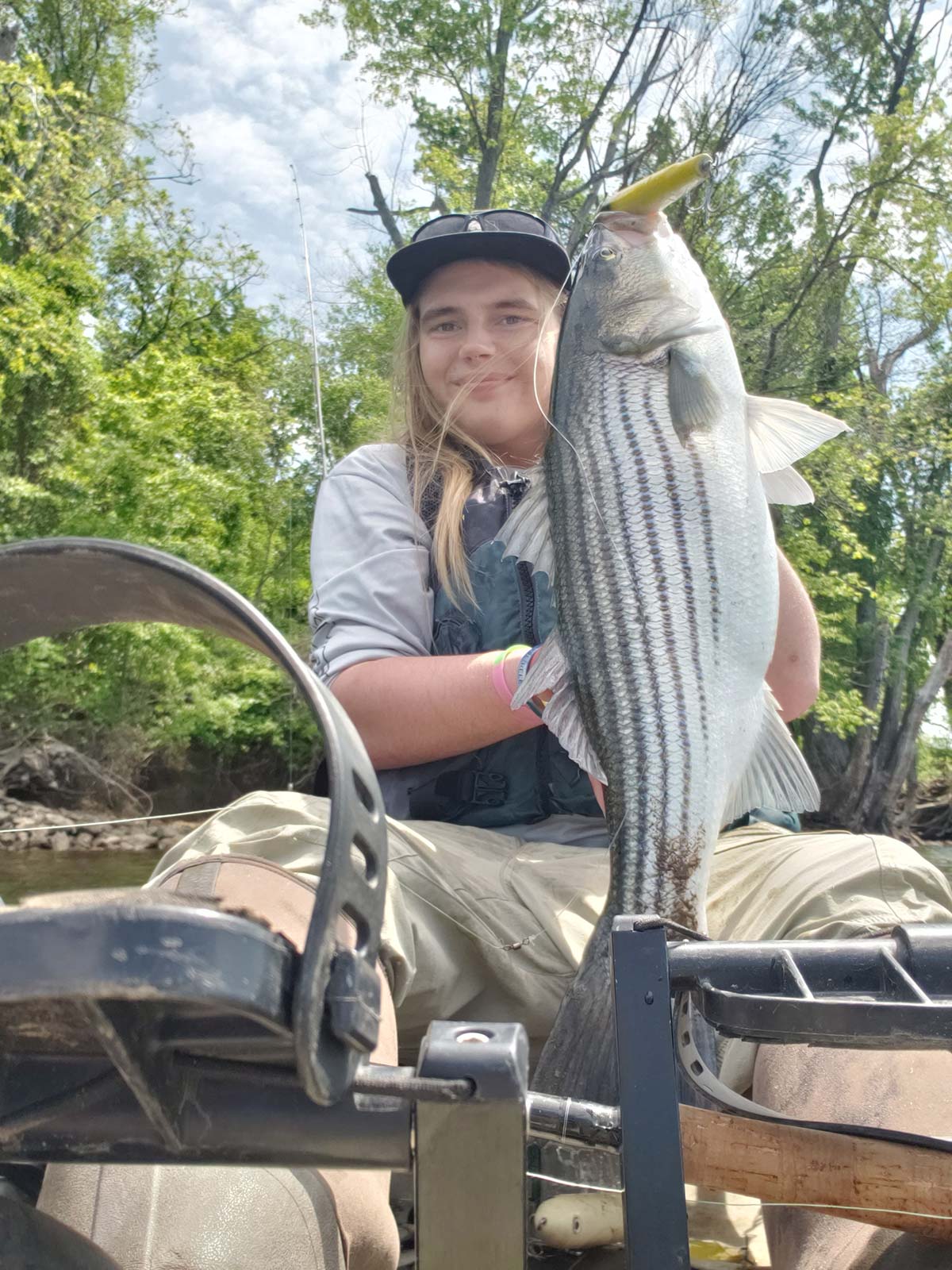
The Warmup
As the water temperature in the river begins to rise, more and more anglers will turn their focus to artificial lures, especially topwater plugs. The stripers may be found gorging on alewives and blueback herring in the tributaries or way upriver and if you find yourself in the midst of a big school of herring, chances are the stripers will not be far away and they are often eager to hit plugs. Topwater presentations are very popular, such as the Lil Doc by Drifter Tackle, the Waterdawg by Windsor Lock’s plug builder Lloyd’s Lures, the Mully made by 24/7 Lures, or any other large spook-style plug. These walk-the-dog-style lures were stolen from the Midwest musky fisherman’s playbook, but the striped bass cannot seem to resist them. These plugs splash, zig-zagging from side to side and do a tremendous job of imitating a wounded baitfish, whether it be a herring, or an adult bunker. Not to be too cliché, but size absolutely does matter when it comes to picking the correct topwater plug for the day, and slight details can be the difference between one fish and a dozen! So make sure you bring options.
Working in the bait business the majority of my life, I’ve been lucky enough to pick up on a few things, and sizing up bait has definitely been one key element to my fishing success. When the bass are hot on bunker, you can often find a school of unbothered pogies on the surface early in the morning that can be caught using a throw net, or a snagged with a weighted treble hook, aka ‘bunker snag’. If catching bait is not your thing, fresh bunker can be purchased from many local tackle shops, or you can stop in and see me at Zah’s Bait and Tackle in Portland.
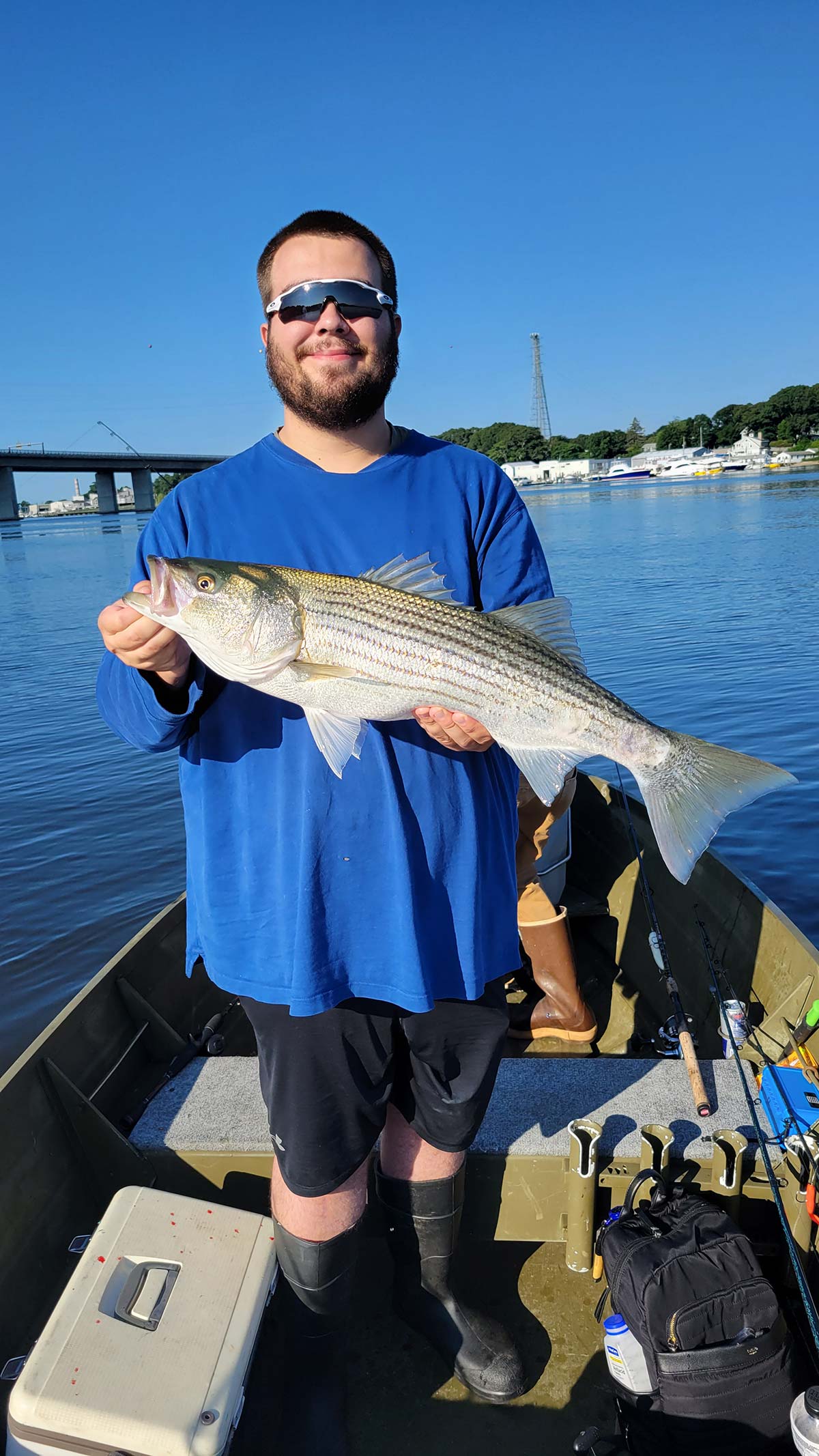
Sizing Up
Even if you intend to fish mostly artificials, it never hurts to keep a few fresh bunker on ice to chunk when or if things get slow. This is where it pays to know the details; an angler can up their catch ratio simply by matching the size of their lure to the size of the bunker in the area—you can find this out by snagging a few or even peeking into the cooler at the tackle shop. The larger the bunker, obviously, the larger the profile plug you want to be throwing. Typically in late-May, when the bass start feeding on bunker, they are the largest they’ll be all year. This might just be my observation, but I believe there is a pattern.
These big adult bunker are best imitated by lures like the Big Doc or, a couple of my local favorites, the Waterdawg or the Big Dawg Glider both made by Lloyd’s Lures. These plugs are a bit larger than the Doc, and throw a bit more water when worked aggressively from side to side. The larger profile has been a key to success in past season’s trips, they seem to consistently out-fish other popular plugs by a noticeable ratio! As spring transitions into summer, the size of the bait begins to vary quite a bit more, and other plugs will have their time to shine, but paying attention to the size of the bait that day can seriously help you up your game!
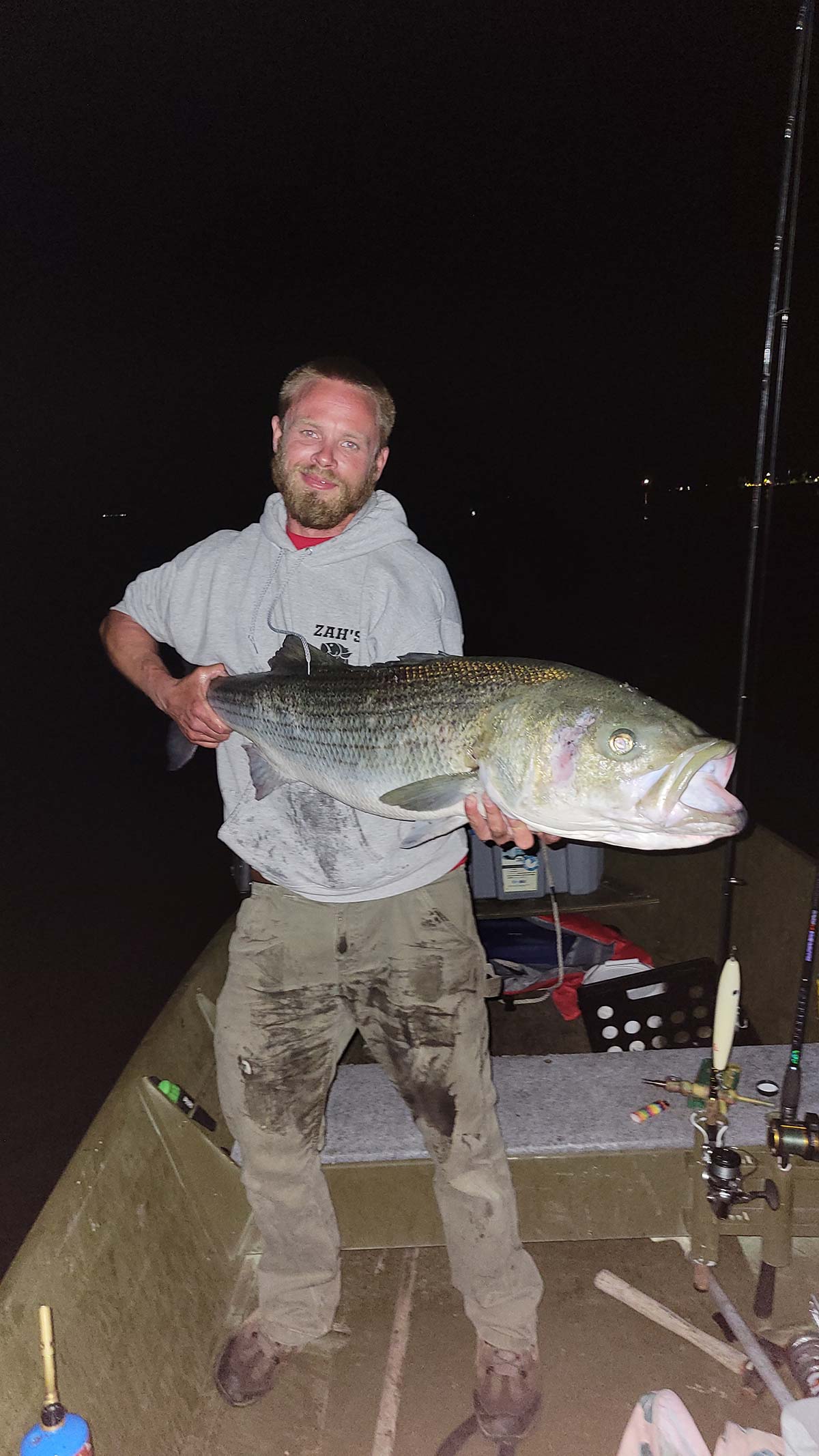
The Real Thing
It’s inevitable that there will be a few days on the river where plugs just aren’t getting it done and the bass make it clear they want the real thing. Live-lining bunker is the ticket to success during these tougher times. Fresh, live bunker is key. If the pogies are getting red in the eyes or the bellies, chances are that bait is toast. It’s very important to keep the water in the livewell circulating and well oxygenated to keep your baits healthy. The quicker the fisherman can get them back out on a circle hook, the better! It’s pretty exhilarating watching striped bass, sometimes several at a time, push a live bunker to the surface, racing for its life. Often times the first few pops on the bunker, the bass actually miss it. This may be in attempt to further wound the bait before they go in for the kill. One of the most frustrating instances is having bass constantly popping on flat-lined pogies, but not having them get eaten. This situation is well described as bass just wanting to kill the bunker, not eat it. As frustrating as it can be, this is no time to give up!
This is when I utilize my own version of the “bait and switch” method. When bass are hot on flat-lined pogies, but not swallowing them, it is worth chancing the tangle of throwing a large soft plastic, aiming to land it almost directly on the bunker. A few fast twitches of the rod tip, to give the plastic an erratic movement away from the live bait, is often enough to steal the bass’s attention away from the bunker, making them think your plastic is another live bait getting away. The bass will often lose interest in the live bait, and will demolish the soft plastic that appears to be getting away from them. Popular plastics for this application, are the 9.5-inch GT Eel by Gravity Tackle, the 9-inch Slug-Go by Lunker City Lures, as well as the Super Snax by Fish Snax Lures. These pair best with a “swimbait” style hook such as the Owner Beast. This method can be very exciting, especially after a few disappointing misses on live bunker!
No matter how an angler chooses to target striped bass, there is no doubt that in May and June, the Connecticut River is a pretty good spot to fish.
